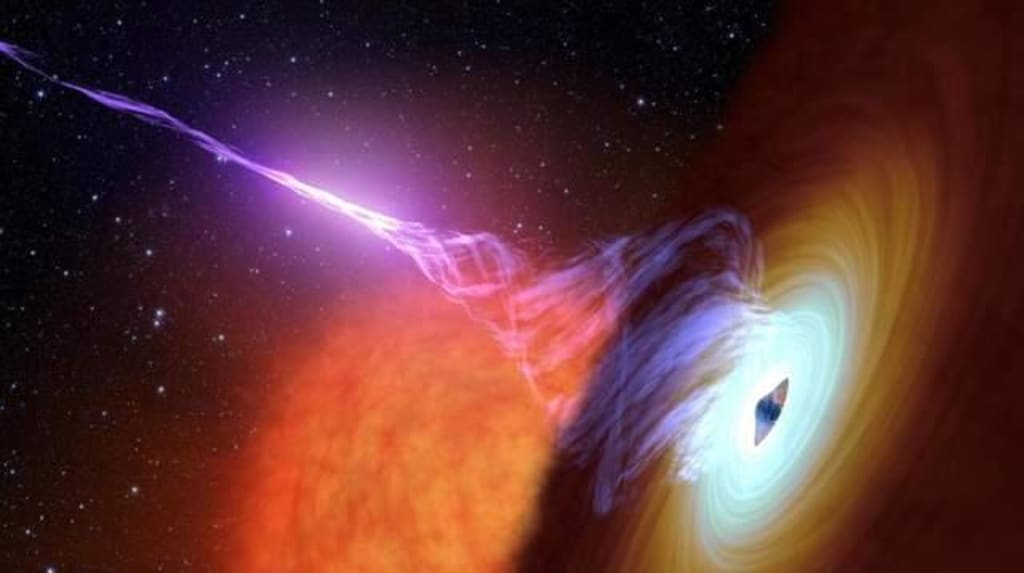Where do all the planets swallowed by black holes end up?
"Hawking radiation"

The gravitational force of black holes is so strong that they can swallow any matter known in the universe, even if they are huge planets, as long as they enter the "sphere of influence" of black holes, they also cannot escape the fate of being swallowed. Here we will talk about this topic.
We know that the size of the gravitational force is inversely proportional to the square of the distance, so when a source of gravity acts on an object, different parts of the object are subject to different gravitational forces, which will form a gravitational difference, thus producing a tearing effect on the object, this effect is also known as the "tidal force".
Black holes do not swallow planets in one gulp as one might think, but there is a process. Because the "tidal force" generated by the black hole is very large, the planet will first be torn into pieces, and then these pieces will be successively attracted to the black hole.
In most cases, the direction of motion of a planet swallowed by a black hole does not point directly toward the black hole, so the pieces of the planet that are torn apart usually rotate around the black hole while approaching it.
In this process, due to the conservation of angular momentum, the closer these fragments are to the black hole, the faster they rotate around the black hole, and at the same time, the dense the material is, when it reaches a certain level, a large amount of material will form a disk-like structure around the black hole at high speed, which is also known as the "accretion disk "This is also called an accretion disk.
The matter in the "accretion disk" has long been torn into atomic or even subatomic states by the "tidal force" generated by the black hole. Because of this, we can indirectly observe the black hole.
At the same time, some of the matter in the accretion disk may also gain enough energy to escape the gravitational field of the black hole, and under the constraint of the magnetic field, these substances will be ejected from the poles of the black hole at high speed, forming a spectacular black hole jet.
Seeing here someone will certainly ask, not that any matter can not escape the black hole. This is explainable.
A black hole is not a hole, but a closed space-time, in three-dimensional space, the black hole can be seen as a sphere, the center of an infinite density, infinitely small volume of the "Singularity" (Singularity), and the surface and radius of the sphere are called the "Event horizon The surface and radius of the sphere are called "Event horizon" and "Schwarzkopf radius" respectively.
Theoretically, any matter that enters the "event horizon" can no longer escape, and the "accretion disk" of a black hole is located outside the "event horizon", so at high enough energy The black hole's accretion disk is located outside the event horizon, so at high enough energy, the matter in it can escape from the black hole's gravity.
This phenomenon has been observed many times in the past, and it shows that some of the matter does not enter the black hole during the process of the planet being swallowed by the black hole.
Of course, the other part of the planet is indeed swallowed by the black hole, and according to general relativity, once the matter enters the "event horizon", it will inevitably fall into the "singularity" at the center of the black hole and become part of the black hole from then on. So is this the final destination of the matter? In this regard, the famous physicist Stephen Hawking gave a negative answer.
According to quantum mechanics, the vacuum is not as empty as imagined, but there is a phenomenon known as "quantum ups and downs", this phenomenon is simply that the vacuum will continue to produce positive and negative virtual particles, they will always be produced in pairs, and then within a very short period annihilation.
Hawking speculated that when the virtual particle pairs appear at the edge of the black hole's "event horizon", there are four possible scenarios: 1) the virtual particle pairs annihilate normally; 2) both virtual particles are swallowed by the black hole at the same time; 3) the negative virtual particles are swallowed by the black hole and the positive virtual particles escape; 4) the positive virtual particles are swallowed by the black hole and the negative virtual particles escape.
According to Hawking's calculation, among the above 4 cases, the 3rd case has the highest probability of occurrence. What needs to be known is that negative virtual particles carry negative energy, so after the black hole swallows the negative virtual particles, its energy is reduced. So where does this energy go? It is taken by the escaping positive virtual particles, of course.
According to the relativistic mass-energy equivalence principle, the loss of energy of a black hole is equivalent to the loss of mass of the black hole, which means that the black hole will become smaller after the above-mentioned scenario 3.
This mechanism is called "Hawking radiation", Hawking believes that black holes will continue to "evaporate" through "Hawking radiation", and as time passes, all the black holes in the universe will sooner or later "evaporate". The black holes in the universe will sooner or later "evaporate" out, and this means that those swallowed by the black hole of the planet matter, and eventually will be through the "Hawking radiation" back to the universe space.
Well, that's all for today, welcome to follow us, we'll see you next time.
About the Creator
Apostolakis
To make scientific, diligence is the mother of success






Comments
There are no comments for this story
Be the first to respond and start the conversation.